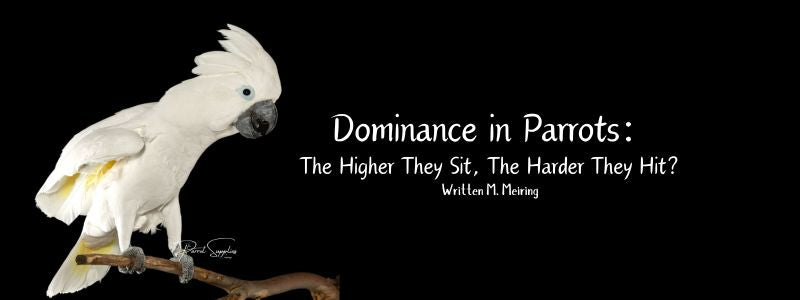Dominance in Parrots (Or, Why Your Fid Might Launch Surprise Attacks)
Welcome, parrot people! Ever wondered why your cockatoo suddenly bites your shirt from above or kamikazes you mid‑air but behaves like an angel when perched on your arm? You’re not alone—and today we’re breaking it down. We’ll explore the science, the behaviour, and my own saga with Marcel the umbrella cockatoo. Spoiler alert: it’s less about dominance and more about comfort, instinct, and situational interpretation.
1. “Height Dominance”—Fact or Fiction?
You’ve probably heard the theory: if your parrot perches on your shoulder or cage and bites when higher, it’s flexing its dominance. But according to avian behaviourists and field research, this is largely mythical.
• Field biologists studying parrots in the wild have observed no clear dominance hierarchies—conflicts are brief, resource-based, and non-laddered.
• Pamela Clark, a certified parrot behaviour consultant, criticises the dominance narrative, explaining that height aggression is short-lived, resource-related, not a battle for alpha status.
• A Reddit avian trainer puts it succinctly: 'Height dominance isn’t real… It’s easy for us to attribute these ‘human motivations’ to our birds because we like to think of them as little people.'
Bottom line: Birds might feel safer higher up—that’s it. No coup d’etat launching from atop your cage.
2. When They Attack from a Perch
A. On Your Shoulder
Why bite from above? It’s not dominance—it’s context. On shoulders:
• Your ear, hair, and face are close, so everything is tempting.
• When you reach to move them, they respond defensively or playfully.
• Parrots learn that bumping you makes you react… to avoid being removed from the shoulder, they bite.
• A bird can just be more comfortable on a shoulder. The problem is when you lose control of reading body language.
B. On Top of Their Cage / Your Back
From a high perch, your turn-away might signal the bird that something’s changed in their environment. Due to instinctive territory defence:
• Wild parrots use aggression to defend resources—not to establish rank.
• Turning your back might be interpreted as vulnerability or challenge to their control of that spot.
C. Mid‑air “Air Bombing”
Why do birds sometimes dive-bomb?
• Dive-bombs are often resource protection, curiosity, or attention-seeking—not dominance.
• Don’t feed the troll. Ignore the behaviour and teach 'step up' instead.
3. So Why Are They Perfect Angels on Your Arm?
Perching on your arm is familiar controlled proximity.
• They can comfortably retreat or step up—no sense of threat.
• You’re holding them, not vying for their territory.
• Skin-on-hand triggers a softer interaction—they know they’ll be treated kindly.
4. My Story: Marcel’s Surprise Bites
Meet Marcel, our umbrella cockatoo.
When we first got Marcel, he was the ultimate sweetheart. But every now and then, while perched on my shoulder, he’d suddenly snap at my head, not a gentle nip—full‑on strike mode and multiple bites. My Citron-crested cockatoo Jewel never did this.
From pure perplexity, we realised: he only snapped when perched higher, never when he was on my hand or relaxing with us. When he jumped from the top of his cage and I turned away, he would launch at my head with surprising force.
It’s not dominance—it’s protection, surprise, and highest vantage behaviour.
5. Science Back-up
A. Birds Aren’t Pack Hierarchists
• Aggression is contextual, not hierarchical.
B. Resources, Not Rank
• Parrots defend nests, food, and territory—not rank.
C. Behaviourists Confirm
• Positive Reinforcement is recommended over dominance-based training.
6. Training & Solutions—Keeping It Friendly
1. Understand Body Language
• Pupil dilation, pinning, fluffing—signs of discomfort.
2. Don’t Feed the Behavior
• Ignore bad behaviour calmly, replace it with a desired one.
3. Teach a Solid 'Step-Up'
• Use treats and praise—reward calm stepping up.
4. Limit Shoulder Time
• Use arms or perches until trust is strong.
5. Offer Natural Behaviour
• Provide flight, foraging, and social time.
7. Marcel’s Training Recap
We tackled Marcel’s height aggression by:
• Adding more floor and play time.
• Teaching a firm step-up with treats.
• Reducing shoulder sessions.
• Watching signs of discomfort early.
Cue improvement—no dramatic head snaps, more peace, more cuddles.
8. Wrap-up
Your parrot isn’t trying to dominate—they want safety and control. Height-based aggression is about spatial comfort—not alpha status.
Stay calm, read the triggers, train with rewards. And enjoy your feathered buddy at all levels.
References
• https://parrots.org/wp-content/uploads/2025/02/The-Struggle-for-Dominance.pdf
• https://avian-behavior.org/problem-with-a-parrot-on-your-shoulder/
• https://hari.ca/avian-care/parrot-training-the-trouble-with-punishment/
• https://pamelaclarkonline.com/2020/02/06/encouraging-natural-behaviors-in-captive-parrots/
• https://thinkparrot.com/aggression-in-parrots/
• https://lafeber.com/pet-birds/questions/amazon-behavior/
• https://somuchpetential.com/should-pet-birds-be-allowed-on-shoulders-2/
• https://naturalencounters.com/wp-content/uploads/2020/04/Understanding_Parrot_Behavior_Naturally-Steve_Martin.pdf

